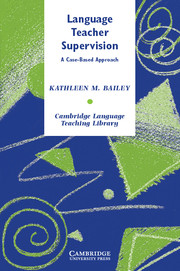Book contents
- Frontmatter
- Contents
- Preface
- Acknowledgments
- Chapter 1 Doing supervision: Roles and skills
- Chapter 2 Awareness and attitude
- Chapter 3 Autonomy and authority
- Chapter 4 Issues in observing language teachers
- Chapter 5 Manual data collection procedures
- Chapter 6 Electronic data collection procedures
- Chapter 7 The post-observation conference
- Chapter 8 Mitigation and the microanalysis of supervisory discourse
- Chapter 9 Purposes, participants, and principles in language teacher evaluation
- Chapter 10 Criteria for language teacher evaluation
- Chapter 11 Supervising preservice language teachers
- Chapter 12 Supervising teaching assistants
- Chapter 13 Supervising in-service language teachers
- Chapter 14 Supervising non-native-speaking teachers
- Chapter 15 Professionalism, paradigm shifts, and language teacher supervision
- References
- Author index
- Subject index
Chapter 10 - Criteria for language teacher evaluation
Published online by Cambridge University Press: 19 February 2010
- Frontmatter
- Contents
- Preface
- Acknowledgments
- Chapter 1 Doing supervision: Roles and skills
- Chapter 2 Awareness and attitude
- Chapter 3 Autonomy and authority
- Chapter 4 Issues in observing language teachers
- Chapter 5 Manual data collection procedures
- Chapter 6 Electronic data collection procedures
- Chapter 7 The post-observation conference
- Chapter 8 Mitigation and the microanalysis of supervisory discourse
- Chapter 9 Purposes, participants, and principles in language teacher evaluation
- Chapter 10 Criteria for language teacher evaluation
- Chapter 11 Supervising preservice language teachers
- Chapter 12 Supervising teaching assistants
- Chapter 13 Supervising in-service language teachers
- Chapter 14 Supervising non-native-speaking teachers
- Chapter 15 Professionalism, paradigm shifts, and language teacher supervision
- References
- Author index
- Subject index
Summary
This chapter examines the thorny issue of the criteria against which language teachers are evaluated. It draws on some early research on the concept of teacher effectiveness – a construct that has been questioned in recent years. We will see that – far from the supervisor's opinion being paramount – many critieria are now involved in language teacher education.
Evaluation entails “the necessary existence and use of a criterion or standard to which the ‘something’ being evaluated may be compared to determine relative worth” (Daresh, 2001:281). But evaluating language teachers is not as straightforward as appraising a used car or an antique chest. The main difficulty lies in determining the standards against which teachers' work will be compared. In fact the criteria “by which quality teaching is assessed may not be made fully clear to the teacher via an observation schedule or specific criteria for judging competent teaching” (Murdoch 1998, Conflicting Discourses section, paragraph 3). Supervisors must answer the fundamental question of what specific criteria will be used in language teacher evaluation. As McGreal (1988) notes, “an essential element of any effective evaluation system is a clear, visible, and appropriate set of evaluation criteria” (p. 13). This chapter discusses the various criteria that can be used in evaluating language teachers' performance.
The following procedures have been recommended by Geddes and Marks (1997:211) for evaluating programs and teachers. First, supervisors should examine evaluation research and reassess the program's existing evaluation model.
- Type
- Chapter
- Information
- Language Teacher SupervisionA Case-Based Approach, pp. 206 - 224Publisher: Cambridge University PressPrint publication year: 2006



